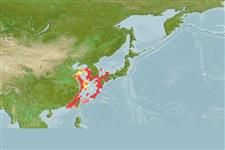>
Clupeiformes (Herrings) >
Dorosomatidae (Gizzard shads and sardinellas)
Etymology: Sardinella: Latin and Greek, sarda = sardine; name related to the island of Sardinia; diminutive (Ref. 45335).
More on author: Bleeker.
Environment: milieu / climate zone / depth range / distribution range
Ekologi
laut; oceanodromus (Ref. 51243); kisaran kedalaman 5 - ? m (Ref. 12166). Subtropical; 38°N - 22°N, 117°E - 134°E (Ref. 54873)
Western Pacific: southern coasts of Japan south to about Taiwan.
Size / Weight / umur
Maturity: Lm ? range ? - ? cm
Max length : 18.0 cm TL jantan/; (Ref. 56557); common length : 10.0 cm SL jantan/; (Ref. 188)
deskripsi pendek
Kunci identifiaksi (pengenalan) | Morfologi | Morfometrik
Duri punggung (Keseluruhan (total)) : 0; Duri dubur: 0. Total scutes 29 to 32. Vertical striae on scales overlapping or continuous (discontinuous in S. fimbriata and S. albella), only a few small perforations on hind part of scale. No dark spot at dorsal fin origin. Most closely resembles S. richardsoni, which has more gill rakers and has a slightly deeper body; S. hualiensis has black tips to dorsal and caudal fins.
Found near shore, including semi-enclosed sea areas, on sandy mud bottom (Ref. 11230). Forms schools in coastal waters. Used in Chinese medicine (Ref. 12166).
Whitehead, P.J.P., 1985. FAO Species Catalogue. Vol. 7. Clupeoid fishes of the world (suborder Clupeoidei). An annotated and illustrated catalogue of the herrings, sardines, pilchards, sprats, shads, anchovies and wolf-herrings. FAO Fish. Synop. 125(7/1):1-303. Rome: FAO. (Ref. 188)
Status IUCN Red List (Ref. 130435: Version 2024-2)
ancaman kepada manusia
Harmless
penggunaan manusia
Perikanan: bernilai komersial tinggi
Alat, peralatan
laporan khas
muat turun XML
Sumber internet
Estimates based on models
Preferred temperature (Ref.
123201): 13 - 24.7, mean 19.7 °C (based on 72 cells).
Phylogenetic diversity index (Ref.
82804): PD
50 = 0.5000 [Uniqueness, from 0.5 = low to 2.0 = high].
Bayesian length-weight: a=0.01202 (0.00681 - 0.02123), b=3.07 (2.92 - 3.22), in cm total length, based on LWR estimates for this species & Genus-body shape (Ref.
93245).
Trophic level (Ref.
69278): 3.2 ±0.3 se; based on diet studies.
Generation time: 2.2 ( na - na) years. Estimated as median ln(3)/K based on 2
growth studies.
Daya lenting (Ref.
120179): Tinggi, Waktu penggandaan populasi minimum kurang dari 15 bulan (tm=1).
Fishing Vulnerability (Ref.
59153): Low vulnerability (22 of 100).
Climate Vulnerability (Ref.
125649): High vulnerability (63 of 100).
Nutrients (Ref.
124155): Calcium = 159 [86, 301] mg/100g; Iron = 1.78 [1.05, 3.19] mg/100g; Protein = 21.2 [20.2, 22.1] %; Omega3 = 0.475 [0.231, 0.905] g/100g; Selenium = 40.5 [21.3, 76.6] μg/100g; VitaminA = 22.7 [6.8, 75.7] μg/100g; Zinc = 0.796 [0.579, 1.188] mg/100g (wet weight);
